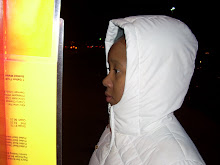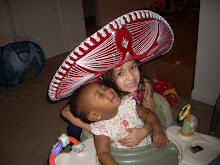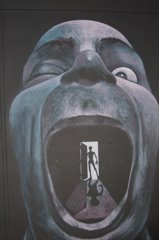HAPPY BIRTHDAY TO ME
HAPPY BIRTHDAY TO ME
HAPPY BIRTHDAY TO MEEEE
HAPPY BIRTHDAY TO ME
20081031
20081029
Uno Dia!!!
I feel the change..I embrace the change...Humble me change
Surprise Visit...See you soon Jadey
Thanks Dad
Surprise Visit...See you soon Jadey
Thanks Dad
20081027
247365
the thing I love about this particular artist is the intricacies.... He tells stories within the paintings..They're Worlds of their own within the scheme of things...How everything is everything and perception is the meaning..(see previous entry)...He wants the surveyors first impression to be the surface...Like when you first meet a beautiful women...Or taste an exotic food for the first time.... It's intriguing, so as you encounter this unknown sight you notice other things making up the surface...The surface is full of complexities and even within those complexities are intricacies....So there is Dali as I see me....Complex and intricate, yet simplistic....So take a journey......
2wenty4our7even
2wenty4our7even
V...isualD...eath

Dali made this painting to warn soldiers of VD's......From a far it tells the story
But what it's made of is the key...
My favorite Artist.......
Mr. Salvador Dali.......Just take a look......
Thanx to authenticsociety.com
the 2nd Piece in my Art installment....Although not My work....It's my inspiration..
HAVE FUN

Dali completed this painting in 1976 and named it "Gala Contemplating the Mediterranean Sea which at Twenty Meters becomes a Portrait of Abraham Lincoln". Dali liked naming his works eccentrically using long names rather than brief descriptions, unlike many traditional artists. This painting's dimensions are 75.5 by 99.25 inches and it's a part of the permanent collection at the Salvador Dali Museum in Saint Petersburg, Florida. As the painting's title suggest, when looked at it from some distance the painting becomes a portrait of Abraham Lincoln. Having seen this painting in person at the museum in Florida, a picture found on the Internet or in a book of this painting (and many other large paintings) does not do the justice. Dali is known for using bright, vivid colors in his paintings that look incredibly sharp in person, it's just something you have to see for yourself, so get yourself out of your house to see his works in person, the tickets are cheap after all and it's definitely worth it.
The painting's subtitle is "Homage to Rothko". Rothko, a famous Latvian-born American artist, has earned his reputation by painting simple paintings that used shapes like squares and rectangles in vivid colors that were considered to be in the style of Abstract Expressionism (Although Rothko was known to have rejected that as the style of his work). This painting may also remind some of the work of the famous American pop-artist Andy Warhol.
Dali liked hiding things in his paintings by using optical illusions. In the middle of this painting, a woman, who is Dali's wife (Gala) looking out of a cross-shaped window overlooking the harbor. The window happens to be a cross that also outlines the shape of Lincoln's head. At the right side, slightly below the horizontal mid-section of the painting we see 4 tiles aligned together to form another cross. By taking a closer look of the upper region of the Abraham Lincoln head, yet another cross painted out as a cloud formation can be spotted. To the left of that cross and directly where the sun is shining through the reddish-orange clouds one can spot a reference to one of Dali's other controversial paintings entitled "Christ of St John of the Cross" which is considered one of the finest works of Salvador Dali. When people think of the most reproduced painting by Salvador Dali, they may falsely guess that it is the famous The Persistence of Memory (with it's Dali's hallmark melting clocks). In reality "Christ of St John of the Cross" is considered to be the most reproduced painting by Salvador Dali.
Some parts of this painting are rendered in the style known as "trompe l'oeli", where adding subtle shadows to the objects makes them seem to leap out from the flat surface of the painting, creating a subtle but very effective 3-dimensional illusion. This effect has been used on the walls in the painting where the plaster is breaking and peeling off, revealing some of the tiles.
Thanx to authenticsociety.com
the 2nd Piece in my Art installment....Although not My work....It's my inspiration..
HAVE FUN

Dali completed this painting in 1976 and named it "Gala Contemplating the Mediterranean Sea which at Twenty Meters becomes a Portrait of Abraham Lincoln". Dali liked naming his works eccentrically using long names rather than brief descriptions, unlike many traditional artists. This painting's dimensions are 75.5 by 99.25 inches and it's a part of the permanent collection at the Salvador Dali Museum in Saint Petersburg, Florida. As the painting's title suggest, when looked at it from some distance the painting becomes a portrait of Abraham Lincoln. Having seen this painting in person at the museum in Florida, a picture found on the Internet or in a book of this painting (and many other large paintings) does not do the justice. Dali is known for using bright, vivid colors in his paintings that look incredibly sharp in person, it's just something you have to see for yourself, so get yourself out of your house to see his works in person, the tickets are cheap after all and it's definitely worth it.
The painting's subtitle is "Homage to Rothko". Rothko, a famous Latvian-born American artist, has earned his reputation by painting simple paintings that used shapes like squares and rectangles in vivid colors that were considered to be in the style of Abstract Expressionism (Although Rothko was known to have rejected that as the style of his work). This painting may also remind some of the work of the famous American pop-artist Andy Warhol.
Dali liked hiding things in his paintings by using optical illusions. In the middle of this painting, a woman, who is Dali's wife (Gala) looking out of a cross-shaped window overlooking the harbor. The window happens to be a cross that also outlines the shape of Lincoln's head. At the right side, slightly below the horizontal mid-section of the painting we see 4 tiles aligned together to form another cross. By taking a closer look of the upper region of the Abraham Lincoln head, yet another cross painted out as a cloud formation can be spotted. To the left of that cross and directly where the sun is shining through the reddish-orange clouds one can spot a reference to one of Dali's other controversial paintings entitled "Christ of St John of the Cross" which is considered one of the finest works of Salvador Dali. When people think of the most reproduced painting by Salvador Dali, they may falsely guess that it is the famous The Persistence of Memory (with it's Dali's hallmark melting clocks). In reality "Christ of St John of the Cross" is considered to be the most reproduced painting by Salvador Dali.
Some parts of this painting are rendered in the style known as "trompe l'oeli", where adding subtle shadows to the objects makes them seem to leap out from the flat surface of the painting, creating a subtle but very effective 3-dimensional illusion. This effect has been used on the walls in the painting where the plaster is breaking and peeling off, revealing some of the tiles.
20081026
5.....28.......10..........Perfection
Halloween has its origins in the ancient Celtic festival known as Samhain (Irish pronunciation: [ˈsˠaunʲ]; from the Old Irish samain).[1] The festival of Samhain is a celebration of the end of the harvest season in Gaelic culture, and is sometimes [2] regarded as the "Celtic New Year".[3] Traditionally, the festival was a time used by the ancient pagans to take stock of supplies and slaughter livestock for winter stores. The ancient Gaels believed that on October 31, now known as Halloween, the boundary between the alive and the deceased dissolved, and the dead become dangerous for the living by causing problems such as sickness or damaged crops. The festivals would frequently involve bonfires, into which bones of slaughtered livestock were thrown. Costumes and masks were also worn at the festivals in an attempt to mimic the evil spirits or placate them.[4][5]
History of name
The term Halloween is shortened from All Hallows' Even (both "even" and "eve" are abbreviations of "evening", but "Halloween" gets its "n" from "even") as it is the eve of "All Hallows' Day",[6] which is now also known as All Saints' Day. It was a day of religious festivities in various northern European Pagan traditions,[3] until Popes Gregory III and Gregory IV moved the old Christian feast of All Saints' Day from May 13 (which had itself been the date of a pagan holiday, the Feast of the Lemures) to November 1. In the ninth century, the Church measured the day as starting at sunset, in accordance with the Florentine calendar. Although All Saints' Day is now considered to occur one day after Halloween, the two holidays were, at that time, celebrated on the same day. Liturgically, the Church traditionally celebrated that day as the Vigil of All Saints, and, until 1970, a day of fasting as well. Like other vigils, it was celebrated on the previous day if it fell on a Sunday, although secular celebrations of the holiday remained on the 31st. The Vigil was suppressed in 1955, but was later restored in the post-Vatican II calendar.
Symbols
The carved pumpkin, lit by a candle inside, is one of Halloween's most prominent symbols in America, and is commonly called a jack-o'-lantern. Originating in Europe, these lanterns were first carved from a turnip or rutabaga. Believing that the head was the most powerful part of the body containing the spirit and the knowledge, the Celts used the "head" of the vegetable to frighten off any superstitions.[7] The name jack-o'-lantern can be traced back to the Irish legend of Stingy Jack, [8] a greedy, gambling, hard-drinking old farmer. He tricked the devil into climbing a tree and trapped him by carving a cross into the tree trunk. In revenge, the devil placed a curse on Jack, condemning him to forever wander the earth at night with the only light he had: a candle inside of a hollowed turnip. The carving of pumpkins is associated with Halloween in North America,[9] where pumpkins were readily available and much larger, making them easier to carve than turnips. Many families that celebrate Halloween carve a pumpkin into a frightening or comical face and place it on their home's doorstep after dark. In America the tradition of carving pumpkins is known to have preceded the Great Famine period of Irish immigration. The carved pumpkin was originally associated with harvest time in general in America and did not become specifically associated with Halloween until the mid-to-late 19th century.
The imagery surrounding Halloween is largely an amalgamation of the Halloween season itself, nearly a century of work from American filmmakers and graphic artists,[10] and a rather commercialized take on the dark and mysterious. Halloween imagery tends to involve death, magic, or mythical monsters. Traditional characters include ghosts, ghouls, witches, owls, crows, vultures, pumpkin-men, black cats, spiders, goblins, zombies, mummies, skeletons, and demons.[11]
Particularly in America, symbolism is inspired by classic horror films, which contain fictional figures like Frankenstein's monster and The Mummy. Elements of the autumn season, such as pumpkins and scarecrows, are also prevalent. Homes are often decorated with these types of symbols around Halloween.
History of name
The term Halloween is shortened from All Hallows' Even (both "even" and "eve" are abbreviations of "evening", but "Halloween" gets its "n" from "even") as it is the eve of "All Hallows' Day",[6] which is now also known as All Saints' Day. It was a day of religious festivities in various northern European Pagan traditions,[3] until Popes Gregory III and Gregory IV moved the old Christian feast of All Saints' Day from May 13 (which had itself been the date of a pagan holiday, the Feast of the Lemures) to November 1. In the ninth century, the Church measured the day as starting at sunset, in accordance with the Florentine calendar. Although All Saints' Day is now considered to occur one day after Halloween, the two holidays were, at that time, celebrated on the same day. Liturgically, the Church traditionally celebrated that day as the Vigil of All Saints, and, until 1970, a day of fasting as well. Like other vigils, it was celebrated on the previous day if it fell on a Sunday, although secular celebrations of the holiday remained on the 31st. The Vigil was suppressed in 1955, but was later restored in the post-Vatican II calendar.
Symbols
The carved pumpkin, lit by a candle inside, is one of Halloween's most prominent symbols in America, and is commonly called a jack-o'-lantern. Originating in Europe, these lanterns were first carved from a turnip or rutabaga. Believing that the head was the most powerful part of the body containing the spirit and the knowledge, the Celts used the "head" of the vegetable to frighten off any superstitions.[7] The name jack-o'-lantern can be traced back to the Irish legend of Stingy Jack, [8] a greedy, gambling, hard-drinking old farmer. He tricked the devil into climbing a tree and trapped him by carving a cross into the tree trunk. In revenge, the devil placed a curse on Jack, condemning him to forever wander the earth at night with the only light he had: a candle inside of a hollowed turnip. The carving of pumpkins is associated with Halloween in North America,[9] where pumpkins were readily available and much larger, making them easier to carve than turnips. Many families that celebrate Halloween carve a pumpkin into a frightening or comical face and place it on their home's doorstep after dark. In America the tradition of carving pumpkins is known to have preceded the Great Famine period of Irish immigration. The carved pumpkin was originally associated with harvest time in general in America and did not become specifically associated with Halloween until the mid-to-late 19th century.
The imagery surrounding Halloween is largely an amalgamation of the Halloween season itself, nearly a century of work from American filmmakers and graphic artists,[10] and a rather commercialized take on the dark and mysterious. Halloween imagery tends to involve death, magic, or mythical monsters. Traditional characters include ghosts, ghouls, witches, owls, crows, vultures, pumpkin-men, black cats, spiders, goblins, zombies, mummies, skeletons, and demons.[11]
Particularly in America, symbolism is inspired by classic horror films, which contain fictional figures like Frankenstein's monster and The Mummy. Elements of the autumn season, such as pumpkins and scarecrows, are also prevalent. Homes are often decorated with these types of symbols around Halloween.
Laundry
A tedious yet necassary process..Washing out the troubles of yesterday through the cycles of life.....But do we still wear our troubles...That shrit or those jeans...How much was made in that outfit...how much did it cost...how much did you lose...Do you lose yourself in your fashion,,...Do YOU wear the clothe or do they wear you...Laundry has been very comforting to me during the years...I like to do it at nite when just the streets are there...Right now its day....still refreshing as tis a BEAUTIFUL DAY in the A....The process...
Gather and Seperate
Insert detergent w/water..
Insert Clothes
Wash and Dry
In between Life happens....
So do I just start anew everyday...
Never wearing yesterday's troubles on today's sleeve....
NO$LEEPgetmoney
2wenty4our7even
Gather and Seperate
Insert detergent w/water..
Insert Clothes
Wash and Dry
In between Life happens....
So do I just start anew everyday...
Never wearing yesterday's troubles on today's sleeve....
NO$LEEPgetmoney
2wenty4our7even
20081025
20081014
Acceptance
Can you accept life... Can you handle what life dishes out...Reality is I cannot....Accept change... Accept YOU being gone....No...Thats not real to me..You are my dreams my hopes my aspirations...So as I pray that school ACCEPTS ME........I only Dream of the day that YOU accept me in your HEART
20081004
The New NEW YORK....presents:
 Show Tulfi a.k.a Showtime a.k.a TRL a.k.a Show Obama
Show Tulfi a.k.a Showtime a.k.a TRL a.k.a Show Obama"Mr. 3 Verse the Songwriter"
He can be heard spittin his real life on the new Charles Hamilton mixtape "Staff Development" now downloadable on nahright.com.... Also he can be heard on any thing new coming from The Demevolist Music Group.................."Ask my nana, I got this" glamour life '08
HAPPY OCTOBER

Well its that time of the year folks....Fall time to recollect restart and bring dreams to life...This is my favorite season, not only is this the month of my birth but its just a great time in general...Time to break out the hoodies, nice leathers and snuggle with that special someone...Definitely time for some Blockbuster nights....So I hope you got u a nice Yamp or Wife to hold you down and cook a nice thanksgiving dinner....If not, and it seems like everyone is breaking up...then just enjoy your freedom, life and long nights of fun....
Shouts to my Cuzo young Show.....And the Homie Charlie Ham....They made they way to the A this week for Clark Homecoming....Hamilton was on the radio last night wit Greg Street Hamiltonizing everyone....can't wait to hear how the A recieves "Brooklyn Girlz".....
Anyway Great to see you living the Life cuzo...Soon enough...
I'm glad we share alot of this music in common and I'm excited to see if it will be YOU to change the family tree....Just remember everything we talk and talked about about this game and THE LIFE.....Keep doin your thing young Homies and GOD will steer your life right......................UNtil.....NO$LEEPgetmoney
"About to put a stranglehold on the game"
2wenty4our7even
20081001
Subscribe to:
Comments (Atom)









